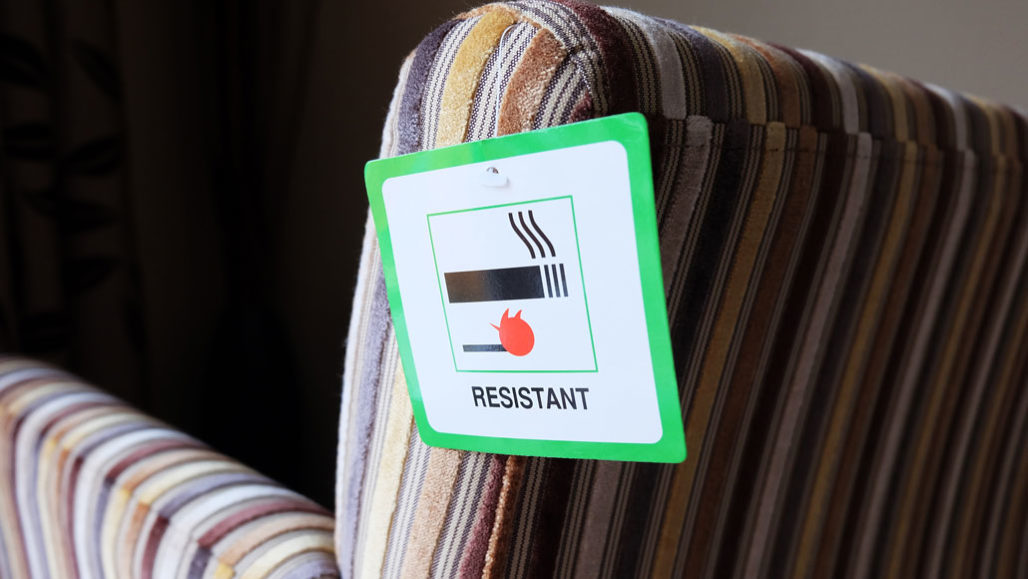Plant-based fire retardants may offer a less toxic way to tame flames / I ritar- danti di fiamma a base vegetale possono offrire un modo meno tossico per domare le fiamme
Segnalato dal Dott. Giuseppe Cotellessa / Reported by Dr. Giuseppe Cotellessa

New plant-based flame retardants could ward off fires without the toxic effects of their commercially used counterparts. / Nuovi ritardanti di fiamma a base vegetale potrebbero allontanare gli incendi senza gli effetti tossici delle loro controparti utilizzate commercialmente.
ANTHONY BOULTON/ISTOCK /GETTY IMAGES PLUS
Scientists have converted acids found in tea leaves and buckwheat into fire-resistant chemicals.
Flame retardants are going green.
Using compounds from plants, researchers are concocting a new generation of flame retardants, which one day could replace the fire-quenching chemicals added by manufacturers to furniture, electronics and other consumer products.
Many traditional synthetic flame retardants have come under fire for being linked to health problems like thyroid disruption and cancer . And flame retardants that leach out of trash in landfills can persist in the environmentfor a long time
The scientists have not yet performed toxicity tests on the new plant-based creations. But “in general, things derived from plants are much less toxic … they’re usually degradable,” says Bob Howell, an organic chemist and polymer scientist at Central Michigan University in Mount Pleasant.
Howell’s team presented the work August 26 in San Diego at the American Chemical Society’s national meeting.
The raw ingredients for these plant-based flame retardants were gallic acid — found in nuts and tea leaves — and a substance in buckwheat called 3,5-Dihydroxybenzoic acid. Treating these compounds with a chemical called phosphoryl chloride converted them into flame-retardant chemicals named phosphorus esters. Since these plant-based ingredients are common, and the chemical treatment process is straightforward, it should be relatively easy to manufacture these flame retardants on a large scale, Howell says.
 A resin commonly used in electronics and vehicles typically catches fire easily (left), but a plant-based flame retardant can keep the resin from going up in flames (right). / La resina comunemente usata nell'elettronica e nei veicoli in genere prende fuoco facilmente (a sinistra), ma un ritardante di fiamma a base vegetale può impedire alla resina di generare fiamme (a destra).
A resin commonly used in electronics and vehicles typically catches fire easily (left), but a plant-based flame retardant can keep the resin from going up in flames (right). / La resina comunemente usata nell'elettronica e nei veicoli in genere prende fuoco facilmente (a sinistra), ma un ritardante di fiamma a base vegetale può impedire alla resina di generare fiamme (a destra).
Howell and colleagues tested the flame retardants in a resin used to make electronics, cars and planes. Compared with chips of pure resin, the resin laced with flame retardant took longer to go up in flames. And “it doesn’t burn for very long, once you get it going,” Howell says. Treated chips were snuffed out in less than 10 seconds, whereas untreated chips blazed until no resin remained. The experiments did not compare the plant-based flame retardants with traditional fire-resistant substances.
The researchers also measured the minimum amount of ambient oxygen required to keep the resin burning. “The higher that number, the better the flame retardant,” Howell says. In gas-filled chambers, untreated resin burned amidst just 19 percent oxygen, whereas treated resin wouldn’t burn without at least 33 percent oxygen.
ITALIANO
Gli scienziati hanno convertito gli acidi trovati nelle foglie di tè e nel grano saraceno in sostanze chimiche resistenti al fuoco.
I ritardanti di fiamma stanno diventando verdi.
Usando i composti delle piante, i ricercatori stanno inventando una nuova generazione di ritardanti di fiamma, che un giorno potrebbero sostituire i prodotti chimici antincendio aggiunti dai produttori a mobili, elettronica e altri prodotti di consumo.
Molti ritardanti di fiamma sintetici tradizionali utilizzati nel ritardare il fuoco sono collegati a problemi di salute come sviluppo di malattie della tiroide e il cancro. E i ritardanti di fiamma che fuoriescono dalla spazzatura nelle discariche possono persistere a lungo nell'ambiente
Gli scienziati non hanno ancora eseguito test di tossicità sulle nuove creazioni a base vegetale. Ma "in generale, le cose derivate dalle piante sono molto meno tossiche ... di solito sono degradabili", afferma Bob Howell, chimico organico e scienziato polimerico presso la Central Michigan University di Mount Pleasant.
Il gruppo di Howell ha presentato il lavoro il 26 agosto a San Diego al meeting nazionale dell'American Chemical Society.
Gli ingredienti grezzi per questi ritardanti di fiamma a base vegetale erano l'acido gallico - presente nelle noci e nelle foglie di tè - e una sostanza nel grano saraceno chiamata acido 3,5-diidrossibenzoico. Il trattamento di questi composti con una sostanza chimica chiamata cloruro di fosforo li ha convertiti in sostanze chimiche ritardanti di fiamma chiamate esteri di fosforo. Poiché questi ingredienti a base vegetale sono comuni e il processo di trattamento chimico è semplice, dovrebbe essere relativamente facile produrre questi ritardanti di fiamma su larga scala, afferma Howell.
Howell e colleghi hanno testato i ritardanti di fiamma in una resina utilizzata per produrre elettronica, automobili e aerei. Rispetto ai frammenti di pura resina, la resina allacciata con ritardante di fiamma impiegava più tempo a generare fiamme. E "non brucia per molto tempo, una volta che lo fai andare", dice Howell. I trucioli trattati sono stati espulsi in meno di 10 secondi, mentre i trucioli non trattati hanno brillato fino a quando non è rimasta resina. Gli esperimenti non hanno confrontato i ritardanti di fiamma a base vegetale con le tradizionali sostanze resistenti al fuoco.
I ricercatori hanno anche misurato la quantità minima di ossigeno ambientale richiesta per mantenere la resina in fiamme. "Maggiore è quel numero, migliore è il ritardante di fiamma", afferma Howell. Nelle camere piene di gas, la resina non trattata bruciava solo con il 19% di ossigeno, mentre la resina trattata non bruciava senza almeno il 33% di ossigeno.
Da:



Commenti
Posta un commento